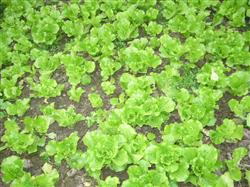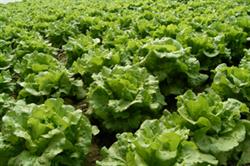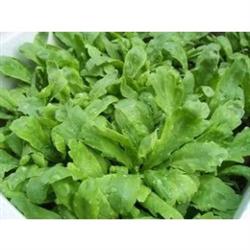Cultivation techniques of lettuce in winter

Varieties were selected to cultivate mid-and late-mature heading lettuce with strong cold resistance. The cultivation date can be planted in solar greenhouse from mid-late November to late January and harvested from the first and middle of January to early March. Fertile sandy loam was selected for seedling breeding, which was fined and made into flat beds. Then apply 100 kg of sifted high-quality manure and 0.5 kg of potassium dihydrogen phosphate every 10 square meters, mix well, level the border surface, water, and sow seeds. Generally use dry seed sowing, can also soak seeds to accelerate budding after sowing. Dry seeds should be sowed with 75% chlorothalonil wettable powder equivalent to 0.3% of the seed weight, but should not be placed for too long. Soak the seeds in 20 ℃ lukewarm water for 7 hours, wrap them in a cloth bag, put them under 20 ℃, rinse with clean water once a day, and sprout after 3 days. Choose to sow seeds in the morning on a windless sunny day, sowing 5 grams of seeds per square meter of seedbed. After sowing, it was covered with a layer of fine soil with a thickness of 3mi 5mm. Before soil preparation, 5000 kg of rotten organic fertilizer and 30 kg of compound fertilizer were applied per mu. After turning deeply, flat beds can be made, and those covered with plastic film can be made into small high beds. Planting solar greenhouse cultivation generally row spacing of 40 cm, plant spacing of 30 cm, watering and cutting tuo before seedling, bring more soil. Open ditches or dig holes for planting, close ditches and flat beds and pour enough water for planting. After planting, the daytime temperature was kept at 20 ℃-24 ℃, and the night temperature was above 10 ℃. During the slow seedling period, the soil was ploughed and loosened for 1 time. After slowing down the seedling, the appropriate temperature should be 15 ℃-20 ℃ during the day, and the slow seedling water should be watered for 10 days after slowing down, and chemical fertilizer should be applied lightly, about 10 kg per mu. After that, ploughing again and squatting seedlings properly. About 15 days later, when the rosette leaves had grown and the heart leaves began to cover the heart, compound fertilizer or ammonium nitrate was applied for 20 kg, and topdressing was applied again during the heading period. Watering times in winter should not be too much, in case the ground temperature or humidity is too high. When entering the pilling stage, the water supply should be uniform, do not suddenly dry and wet, so as not to crack the ball or make the ball leaf open and grow. Stop watering for 5 days before harvest.
- Prev

Fertilizer requirement characteristics and fertilization skills of heading lettuce
The characteristics of fertilizer requirement of heading lettuce is a herbaceous plant of Asteraceae lettuce, which is suitable for slightly acidic clay soil or soil with rich organic matter and strong ability of water and fertilizer conservation. The growth cycle of heading lettuce can be divided into germination stage, seedling stage, rosette stage and heading stage. It is generally believed that every 1000 kilograms of lettuce needs to absorb 3.7kg of nitrogen.
- Next

Cultivation techniques of Artemisia annua in greenhouse in early spring
It is better to select varieties with strong cold resistance, and it is generally necessary to use 1.5-2kg per mu. Three to five days before sowing, the seeds were soaked in warm water of 30 ℃ for 24 hours. After washing and drying, they were placed under the condition of 15: 20 ℃ to accelerate germination. The seeds were washed with warm water once a day, and the seeds could be sown after germination. Fertilize the whole.
Related
- Where is it suitable to grow horseradish in China? it is expected to see the middle altitude horseradish in Alishan.
- How to prevent tomato virus disease reasonably? (Control methods included)
- Many people like to plant towel gourd on the balcony. What are the main points of this method and management?
- What crops can chili peppers be mixed with?
- Fertilization techniques and matters needing attention in Tomato
- What are the grafting techniques for peach seedlings in spring?
- Harm and control methods of root swelling disease of Chinese cabbage
- What are the pests of sweet potatoes? How to prevent and cure it?
- Symptoms, causes and Control methods of navel Rot in Tomato
- The cause of "Cucumber rotten bibcock" in Farmers' planting Cucumber and its Control Plan

